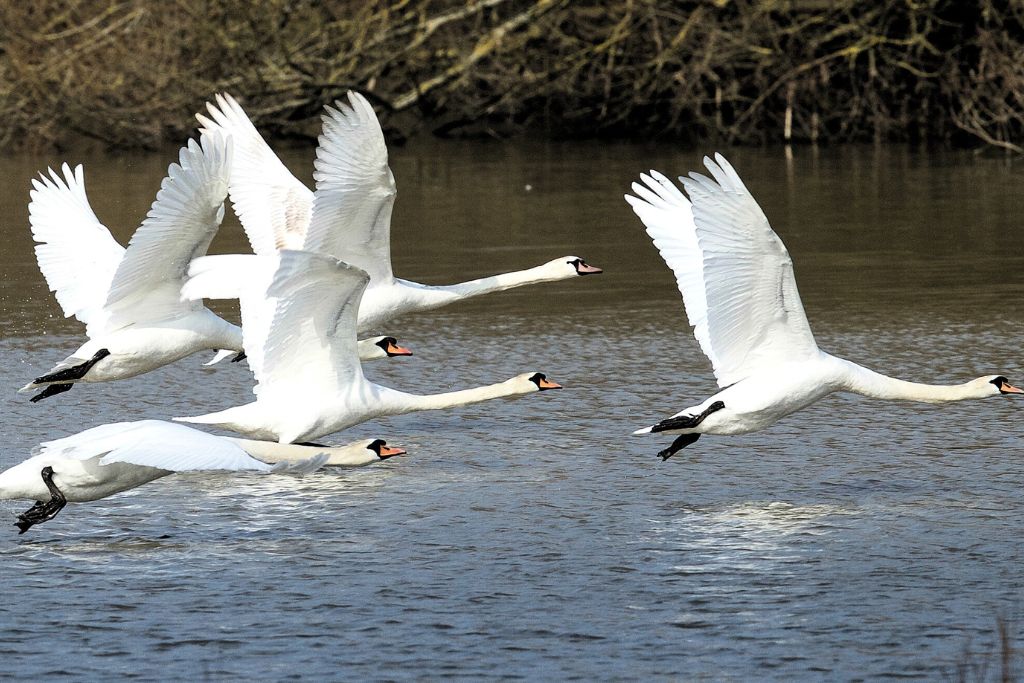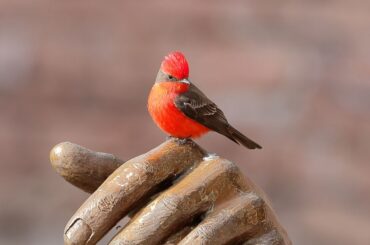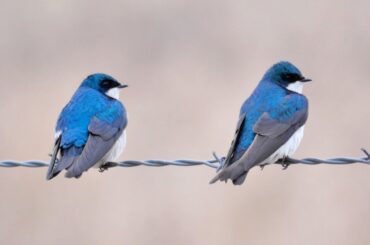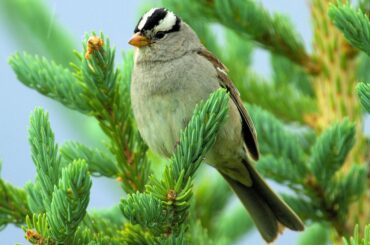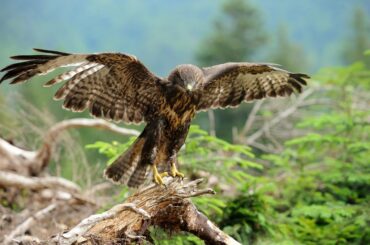Did you know Michigan is home to some of the most incredible giant birds? Imagine spotting a bald eagle soaring through the skies or witnessing the elegant dance of the Sandhill Crane.
If you’re a bird watcher or enthusiast, get ready to be amazed as we take you on a journey to explore these magnificent 20 Large Birds in Michigan.
From their massive wingspans to their unique behaviors, this article will introduce you to the wonders of these majestic creatures, making your birdwatching adventures even more exciting.
So, grab your binoculars and dive into the captivating world of Michigan’s giant avian residents!
What do Large Birds Look Like in Michigan?
Large birds in Michigan share several common characteristics that make them unique and captivating. These magnificent creatures come in various sizes, with some boasting impressive wingspans.
Michigan’s huge birds are colorful. The bald eagle’s dark brown body and bright white head and tail make it a spectacular sight in the skies. Many of these birds have barred or mottled plumage to conceal better.
These large birds can be found in various locations throughout Michigan. Wetlands, forests, and areas near water bodies are typical habitats for them.
When exploring Michigan’s landscapes, you might hear the haunting calls of the sandhill cranes or the distinctive screeches of the bald eagle, adding to the experience of encountering these magnificent creatures.
Birding guides and online resources provide helpful maps for bird enthusiasts looking to identify and locate the most common large birds in Michigan. These resources can guide you to the best areas to observe these birds and listen to their enchanting sounds.
Great Gray Owl
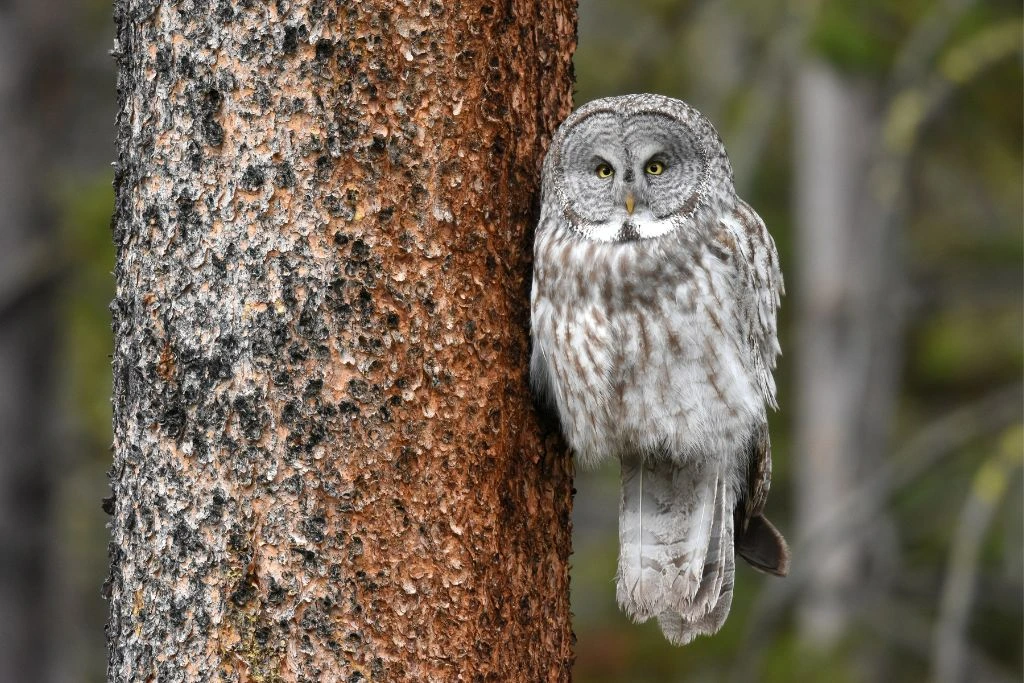
- Kingdom: Animalia
- Phylum: Chordata
- Class: Aves
- Order: Strigiformes
- Genus: Strix
- Species: S. nebulosa
The Great Gray Owl (Strix nebulosa) is one of the largest owl species in North America, with a wingspan of up to 60 inches and a height of 24 to 33 inches. It has a large, rounded head with distinctive gray plumage, facial disks, and bright yellow eyes. These owls possess excellent hearing and silent flight, allowing them to locate and capture prey precisely.
Large face disks deliver sound to their ears, helping them hunt voles and mice. Their dense feathers keep them warm, and their ears help them discover creatures under snow.
Monogamous great gray owls mate for life. They nest in tree cavities, old hawk nests, or huge limbs. Females lay 2 to 5 eggs and incubate them for 30 days. During this time, the male feeds. After hatching, babies stay in the nest for four weeks before exploring surrounding branches. Until they’re independent, parents provide and protect their children.
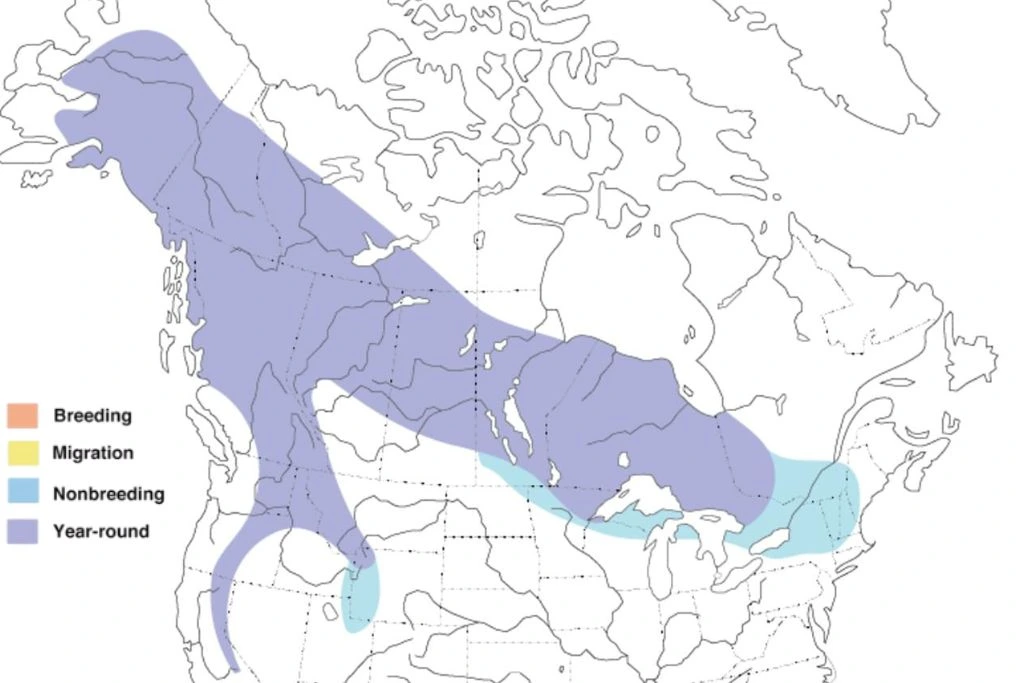
Even in the snow, the great gray owl can hear its prey. Their powerful talons help them to catch snow-buried animals. Due to their wings’ vibration-absorbing feathers, they can fly silently despite their vast size. This species of owl is the longest-lived.
The Great Gray Owl is usually seen in the Upper Peninsula in Michigan. Large coniferous forests and good hunting grounds are where they are most likely to be found.
Gyrfalcon
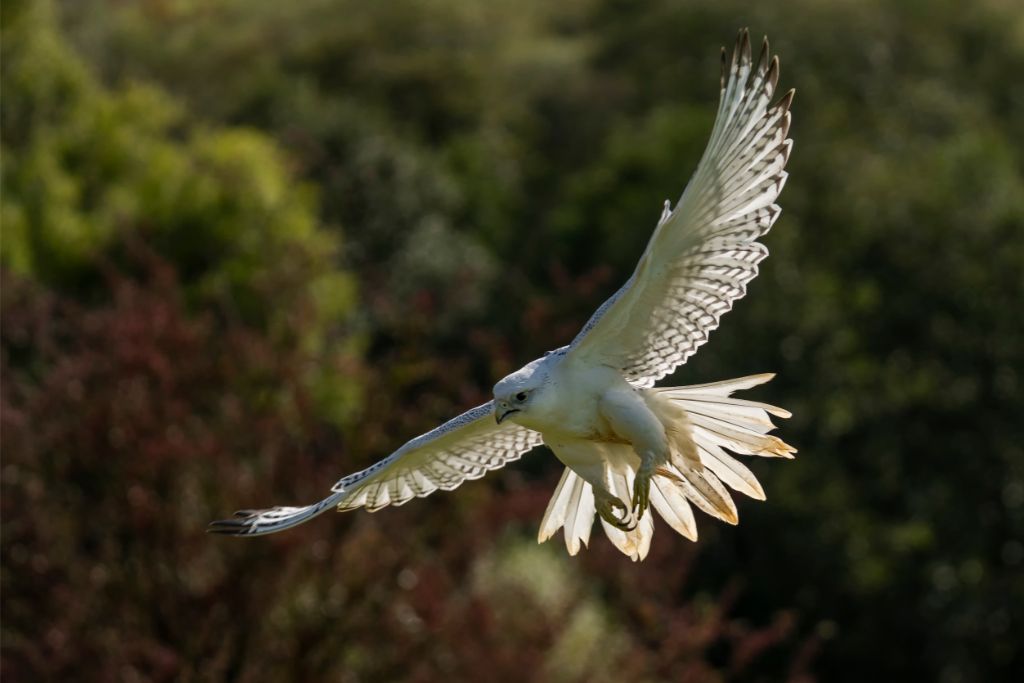
- Kingdom: Animalia
- Phylum: Chordata
- Class: Aves
- Order: Falconiformes
- Genus: Falco
- Species: F. rusticolus
The Gyrfalcon (Falco rusticolus) is a large falcon species, often considered the largest falcon in the world. It has a wingspan ranging from 41 to 48 inches and 19 to 24 inches long.
From deep brown to practically white, the Gyrfalcon’s plumage can vary. These falcons destroy their prey with their sharp, hooked beaks and strong talons.
The Arctic temperature suits the gyrfalcon. Their large feathers protect them from the cold. Falcons may fly over 100 mph when hunting. They can hunt ptarmigans and ducks in the tundra and near the beach in colder areas.
Most Gyrfalcon partnerships last a lifetime. They nest in bird cavities, on the ground or cliff ledges. A female gyrfalcon will incubate 3 to 5 eggs for around a month. The chicks need both parents for food and care until they can fly at 40 to 45 days old.
The Gyrfalcon’s hunting skills and flexibility make it a popular bird of prey. To catch their food, they may dive at high speeds or chase it on the ground.
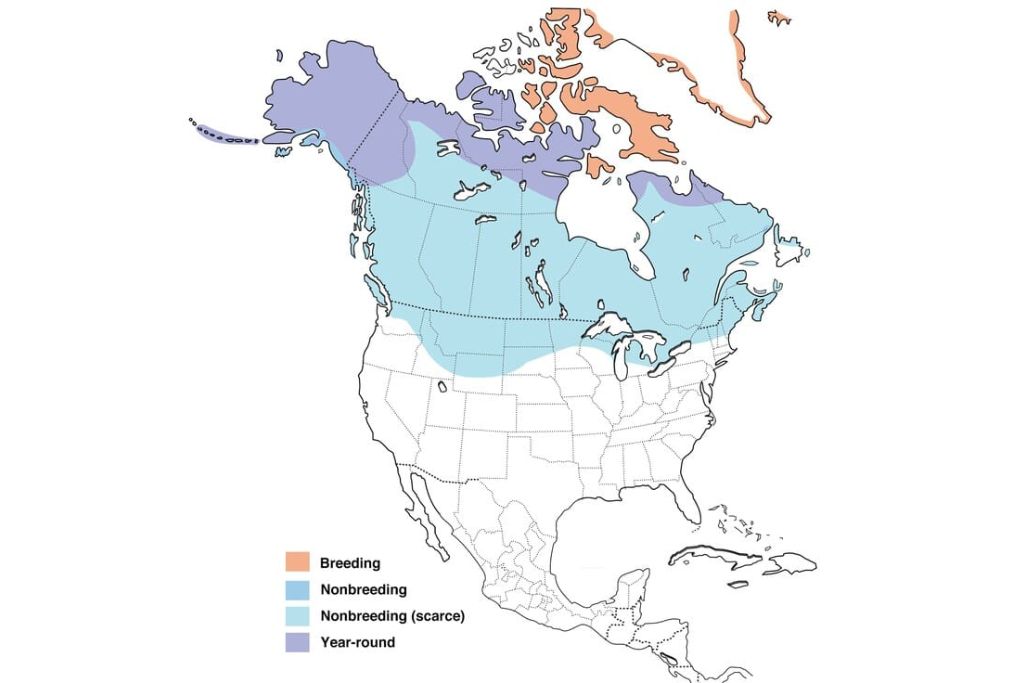
The Gyrfalcon, a huge, powerful, and beautiful bird, is popular in falconry. One of the longest-lived bird species, it can survive 15 to 20 years in the wild.
Michigan winters rarely see gyrfalcons. The Upper Peninsula’s Great Lakes shorelines are where you’ll see them. Along coasts with broad spaces and decent hunting, these gorgeous birds cluster.
Trumpeter Swan
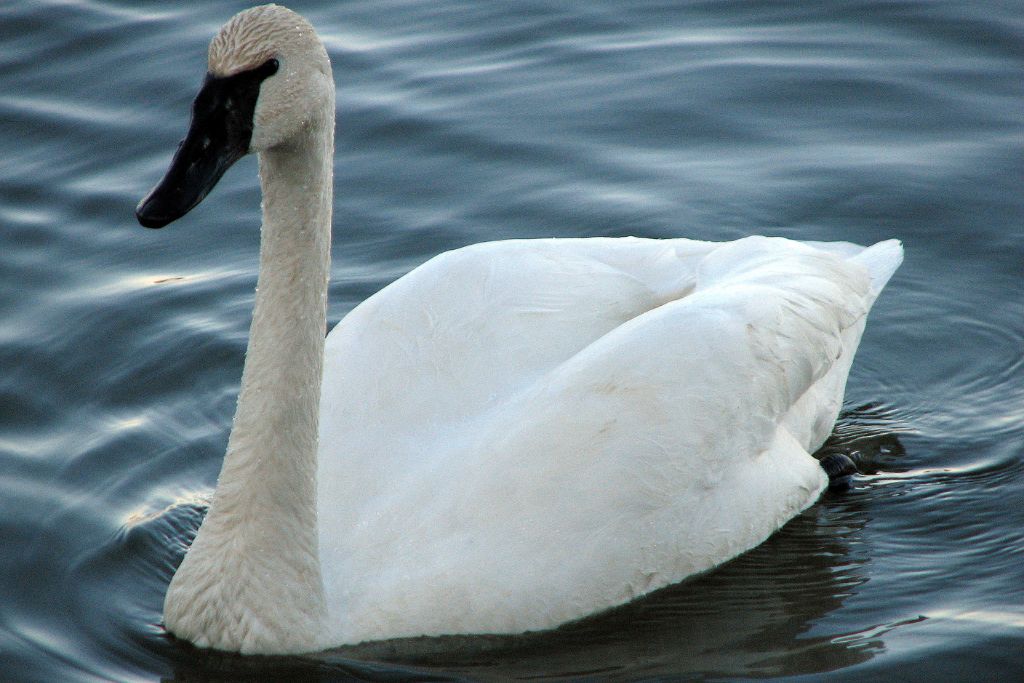
- Kingdom: Animalia
- Phylum: Chordata
- Class: Aves
- Order: Anseriformes
- Genus: Cygnus
- Species: C. buccinator
North America’s largest native duck, the trumpeter swan (Cygnus buccinator), has a wingspan of 8 feet and weighs 20 to 30 pounds. They have lengthy necks, pristine white feathers, and black bills. Swans are agile swimmers and beautiful.
Their long necks let them access shallow-water vegetation. Webbed feet let them cross lakes, ponds, and marshes. They feed and breed in Michigan’s vast lakes, marshes, and rivers.
Trumpeter swans create lifelong monogamous partnerships. Near water, they make enormous plant nests. The female lays 4 to 6 eggs, which both parents incubate for 32 to 37 days. Cygnets (baby swans) are raised by their parents and learn to swim and forage. Until the young swans leave, the family stays together.
In the wild, Trumpeter Swans can live 20 to 30 years. Their trumpet-like sounds give these swans their name. They have recovered after becoming nearly extinct in Michigan owing to overhunting and habitat destruction.
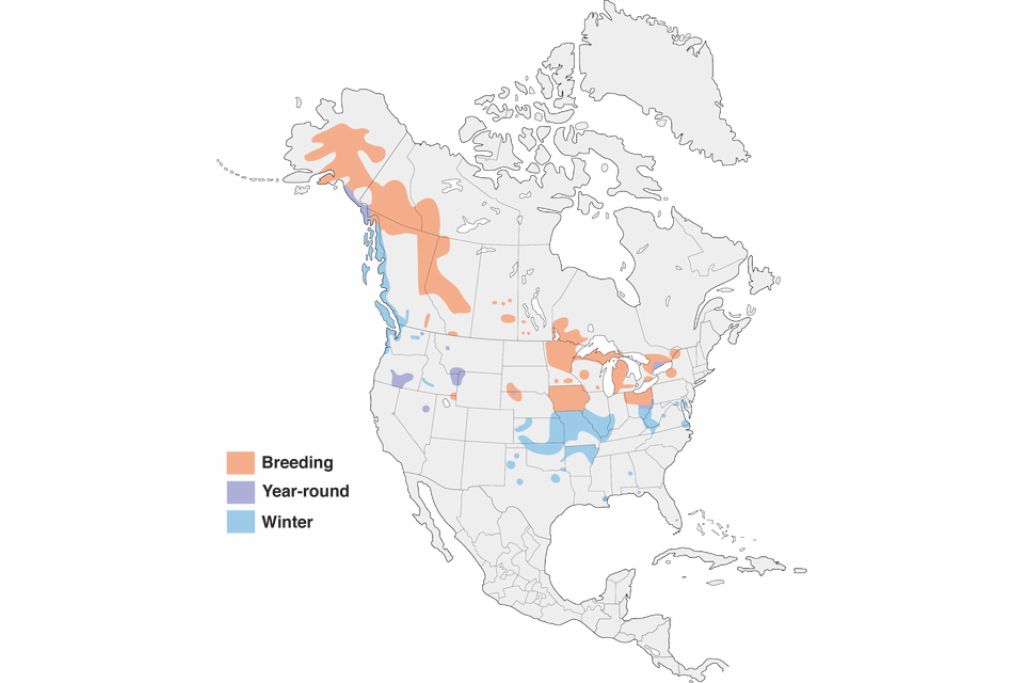
Trumpeter swans are often seen in Michigan’s Upper Peninsula, northern Lower Peninsula, and southwestern area. They live in vast amounts of water like the Great Lakes, marshes, ponds, and rivers.
Bald Eagle

- Kingdom: Animalia
- Phylum: Chordata
- Class: Aves
- Order: Accipitriformes
- Genus: Haliaeetus
- Species: H. leucocephalus
The bald eagle (Haliaeetus leucocephalus) has dark brown bodies that contrast with their white head and tail. Their hooked beak and strong claws help them grasp and grip prey. They have excellent eyesight and can see their prey from far away.
The bald eagle is well-suited to live near water. It has powerful wings that allow it to soar and reach high speeds. The eagle’s eyes are designed to see forward and to the sides, helping it locate prey. These majestic birds inhabit various habitats in Michigan, including coastal areas, lakes, rivers, and marshes.
They build enormous nests called eyries, usually in tall trees near water. They add to their nests each year, which can grow to impressive sizes. The female bald eagle lays 1 to 3 eggs, and both parents take turns incubating them for about 35 days.
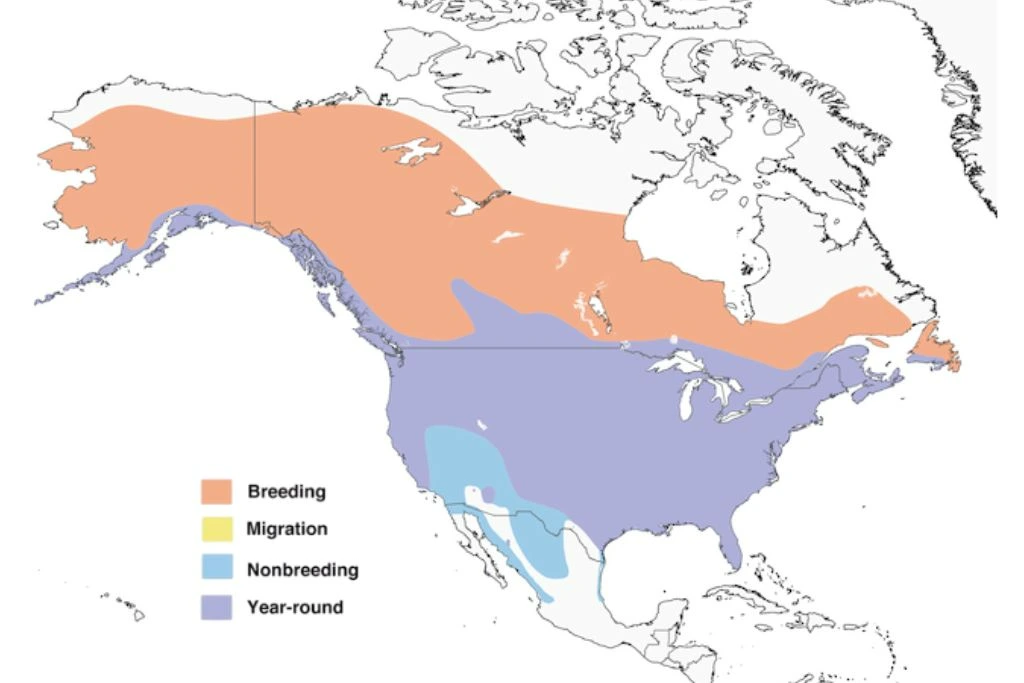
Bald eagles boast an impressive lifespan, with some individuals living up to 20 to 30 years in the wild. Notably, they are not bald, but instead named for their white-feathered heads that stand out against their dark bodies.
Great Blue Heron
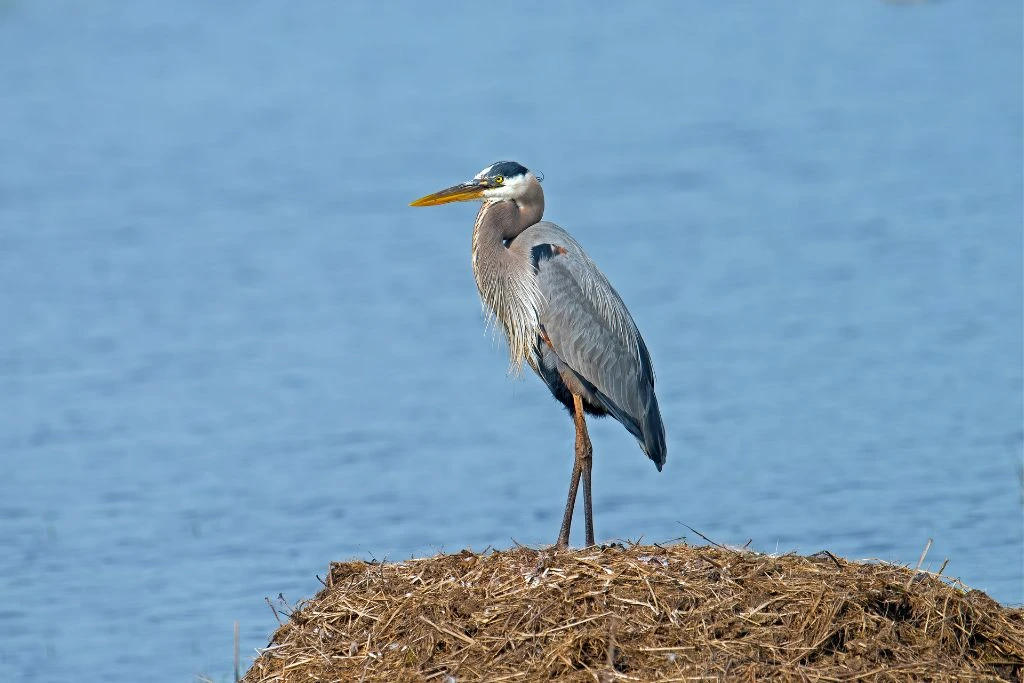
- Kingdom: Animalia
- Phylum: Chordata
- Class: Aves
- Order: Pelecaniformes
- Genus: Ardea
- Species: A. herodias
The Great Blue Heron (Ardea herodias) is a large bird in Michigan, standing around 4 feet in height, with a wingspan of about 6 feet. It has long legs, a long neck, and a dagger-like bill.
A Heron’s body is predominantly bluish-gray, with a white face and a black stripe above its eyes. Its slow and steady wingbeats and graceful movements are a sight to behold in flight. Its sharp bill enables it to strike quickly and precisely catch its prey.
Great blue herons are commonly found near bodies of water in Michigan, such as lakes, rivers, marshes, and coastal areas. They are known for their distinctive and loud “squawk” calls, which can be heard in their breeding colonies.
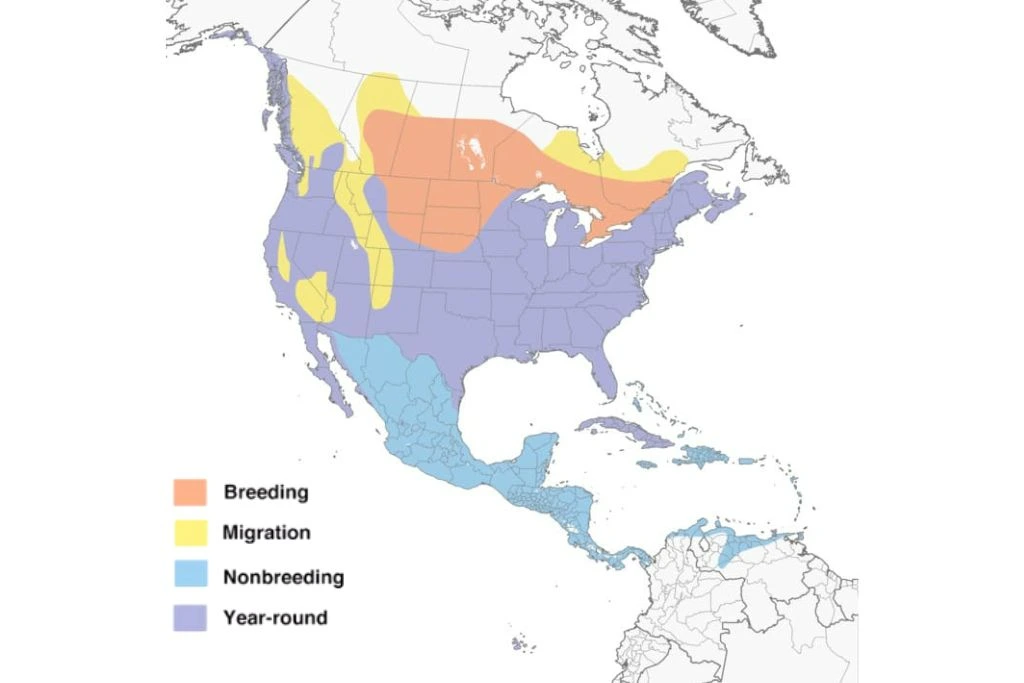
These herons are excellent hunters, employing their patience and stealth to capture prey in the water. Despite their large size, they can move silently and blend into their surroundings, making them skilled at surprise attacks.
Glaucous Gull
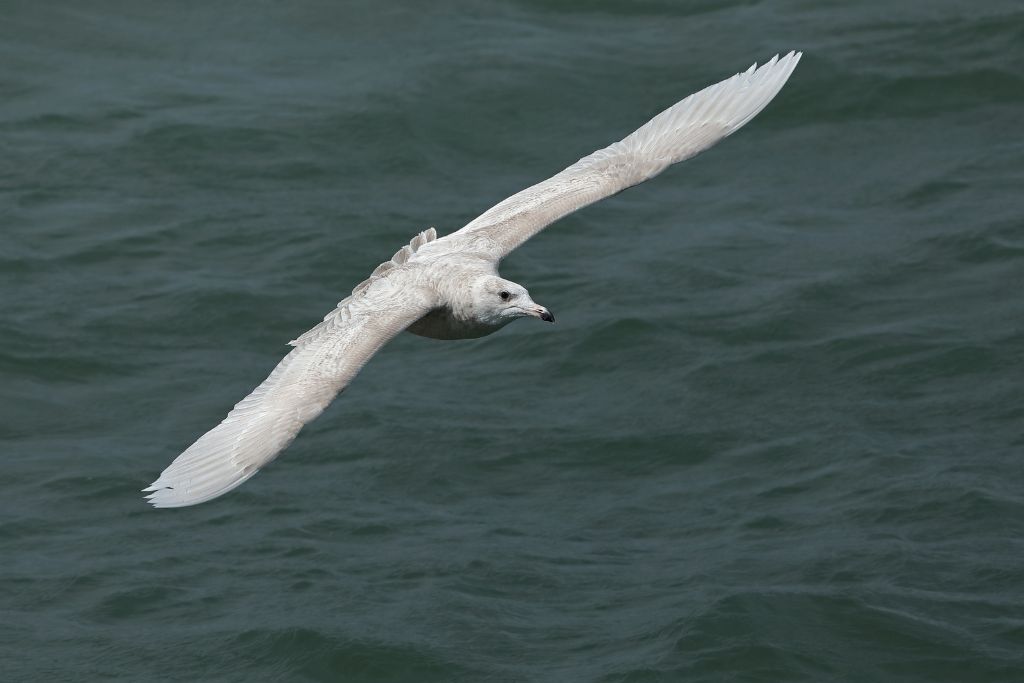
- Kingdom: Animalia
- Phylum: Chordata
- Class: Aves
- Order: Charadriiformes
- Genus: Larus
- Species: L. hyperboreus
The Glaucous Gull (Larus hyperboreus) is a large bird in Michigan with a wingspan of 5 to 6 feet and a weight of 3 to 5 pounds. It has robust white plumage and pale gray wings. The gull’s yellowish-green, slightly hooked beak lets it grab and eat various animals. They have pinkish legs and pale or light gray eyes.
In cold coastal locations, glaucous gulls flourish. Their thick feathers protect them. Coastal, estuary, and nearshore seas are home to these birds. Fish, sea invertebrates, and small animals are their prey. They’re strong flyers.
Glaucous gulls breed in the Arctic and winter in Michigan. Monogamous pairs nest on the ground or cliffs. Both parents incubate 2 to 4 eggs for 25 to 28 days. Parents feed and fledge the chicks at 40 to 45 days. Glaucous gulls mature sexually at 4 to 5 years.
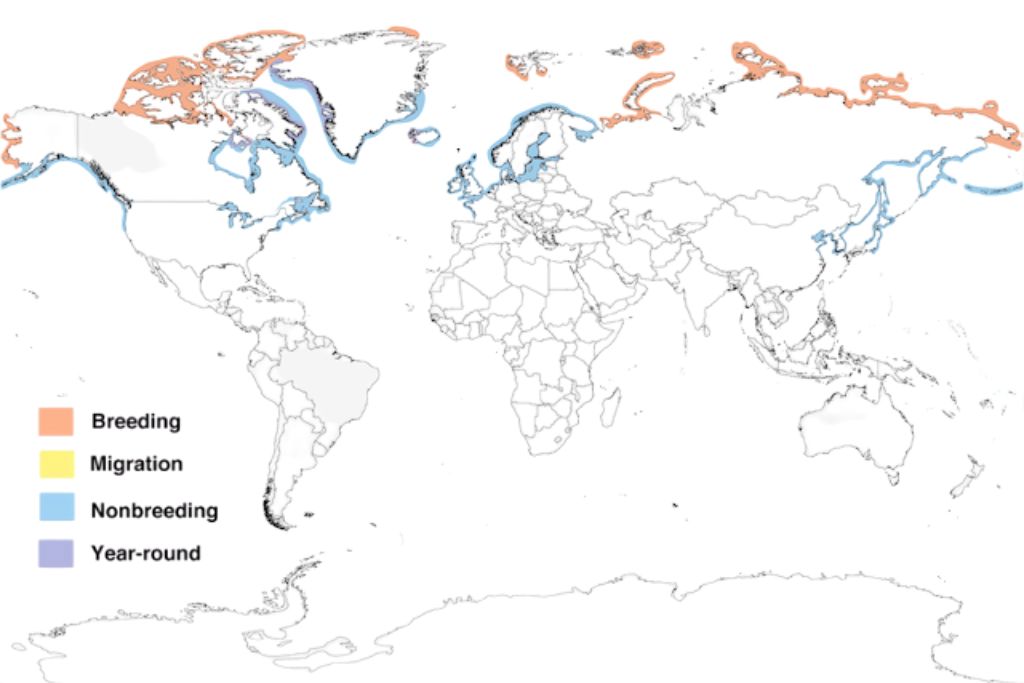
The average lifespan of a wild glaucous gull is 15 to 20 years. Their calls have been described as both “laughing” and “mewing.” They frequent areas with fishing boats and coastlines in search of food.
Common Loon
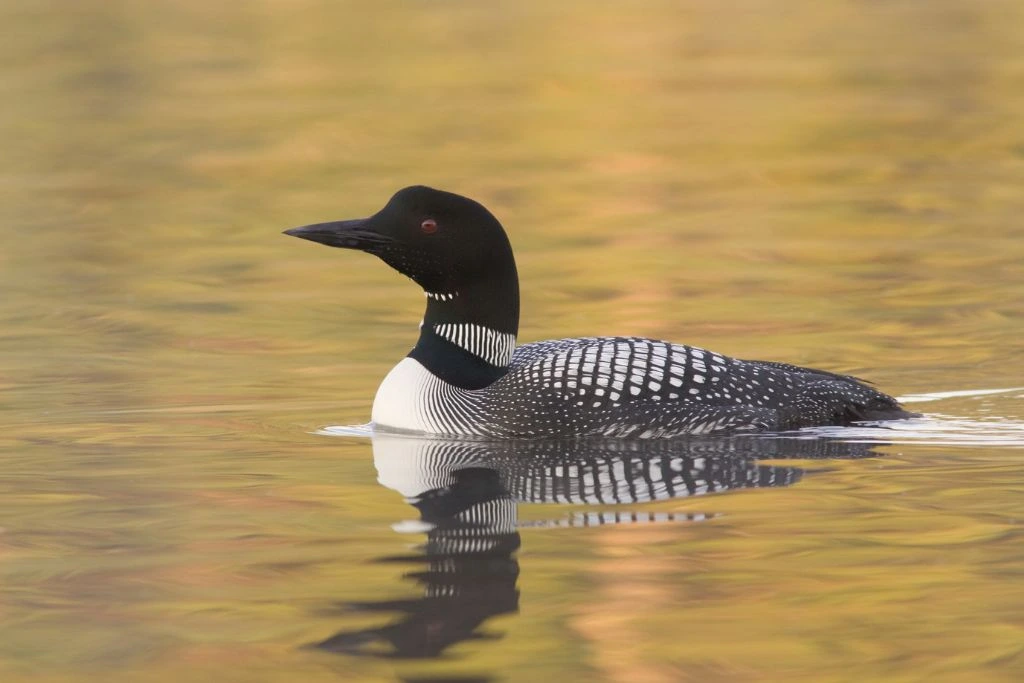
- Kingdom: Animalia
- Phylum: Chordata
- Class: Aves
- Order: Gaviiformes
- Genus: Gavia
- Species: G. immer
The Common Loon (Gavia immer) is a large bird, measuring around 28 to 36 inches in length with a wingspan of approximately 4 to 5 feet. They have sleek streamlined bodies, with a black head and neck, a white breast, and a distinctive checkerboard pattern on their back. Their bill is long and pointed, and their legs are set far back on their body, making them excellent swimmers but less agile on land.
Common Loons are well adapted for life in the water. Their bodies are designed for diving, with solid bones that reduce buoyancy and powerful legs that propel them underwater. Their feet have lobed toes, which aid in swimming and diving.
These Loons are typically found in freshwater habitats, such as lakes and ponds in Michigan. They have excellent hearing and can detect underwater sounds, allowing them to locate and catch fish, their primary food source.
Both parents care for 1 to 3 eggs the female lays for 25 to 30 days. Parents feed and carry chicks until they can swim and find food independently.
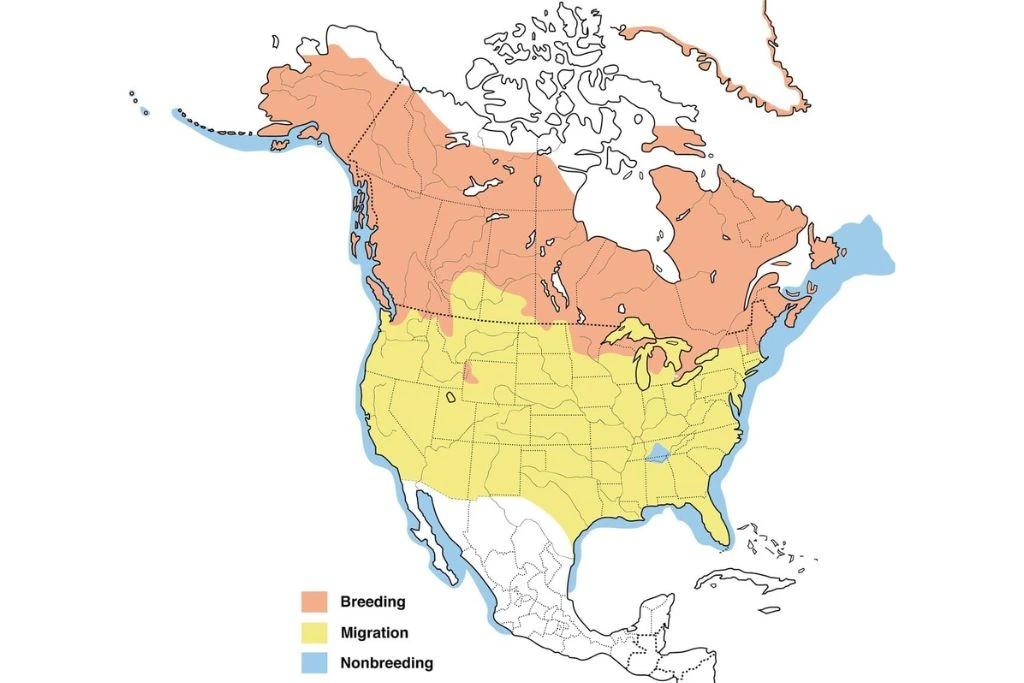
A Common Loon’s lifespan is about 20 to 30 years in the wild. They are known as large birds in Michigan and their spooky and scary calls, which they use to mark their territory and get in touch with other birds.
The most common large birds in Michigan, these famous birds are generally associated with Michigan’s lakes. They are often heard and observed on lakes like the Great Lakes, Lake St. Clair, Torch Lake, and Houghton Lake. Birdwatchers and environment lovers love their unique sounds and appearance.
Osprey
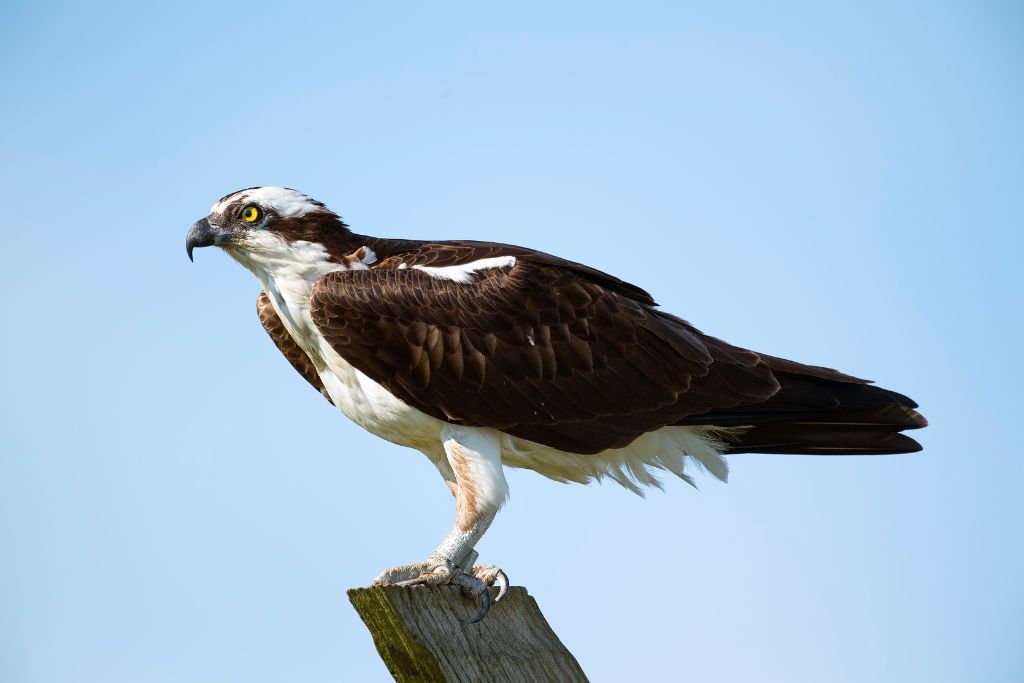
- Kingdom: Animalia
- Phylum: Chordata
- Class: Aves
- Order: Accipitriformes
- Genus: Pandion
- Species: P. haliaetus
Ospreys (Pandion haliaetus) are one of the most common large birds in Michigan, with a wingspan of about 5 to 6 feet and a length of around 2 feet. Its unique appearance features brown feathers on its upper body, white feathers on its underbody, and a white head adorned with a dark eye stripe.
With its sharp, curved beak and powerful talons, the osprey is well-equipped for catching and gripping fish, which comprise most of its diet. They have a unique adaptation called a “talon cam” that lets them line up their outer toes with their inner toes. This gives them a better grip on slippery food.
These large birds in Michigan are known as “expert hunters” and dwell near bodies of water. Their specialized vision enables them to spot fish from high altitudes, while their long, curved wings aid in soaring and hovering above water during their search for prey.
They are frequently spotted near lakes, rivers, and coastal areas, where they construct their nests on platforms, dead trees, or man-made structures like utility poles. The Osprey is truly adapted to thrive in aquatic habitats.
Ospreys make amazing nests from sticks and other items. Each breeding season, the same partners add and repair their nests. Ospreys do aerial acrobatics and make high-pitched sounds in courtship displays.
In the wild, the normal lifespan of an Osprey is between 10 and 20 years. These amazing birds are excellent divers and can jump into the water from up to 100 feet (30 meters) in the air to catch fish.
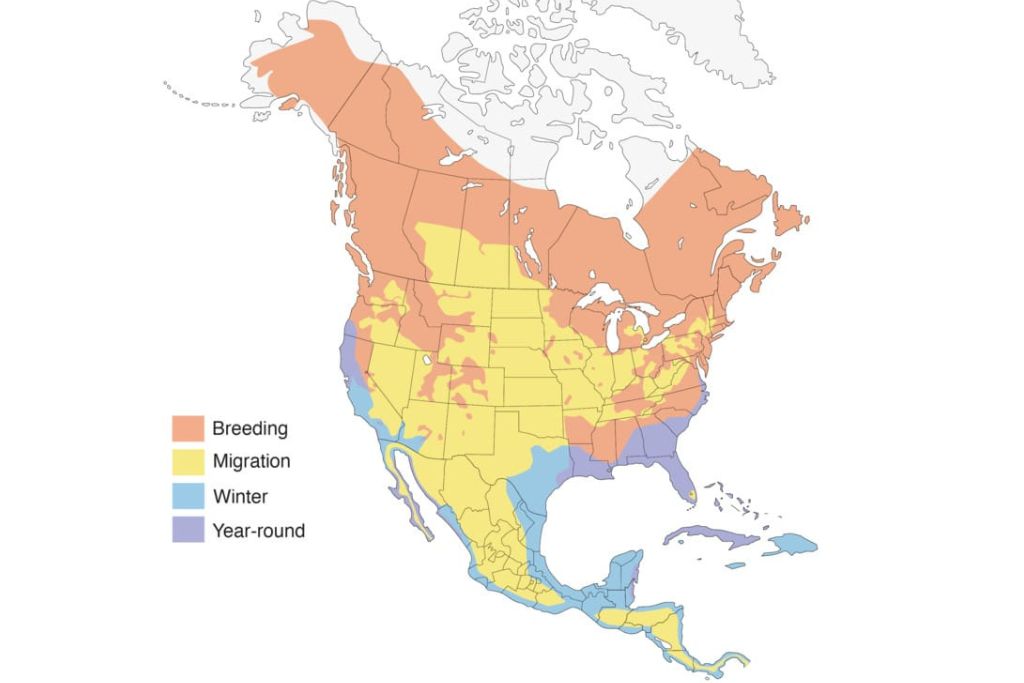
Many Ospreys from Michigan travel to Central and South America during the winter because they are birds that migrate.
Great Black-backed Gull
- Kingdom: Animalia
- Phylum: Chordata
- Class: Aves
- Order: Charadriiformes
- Genus: Larus
- Species: L. marinus
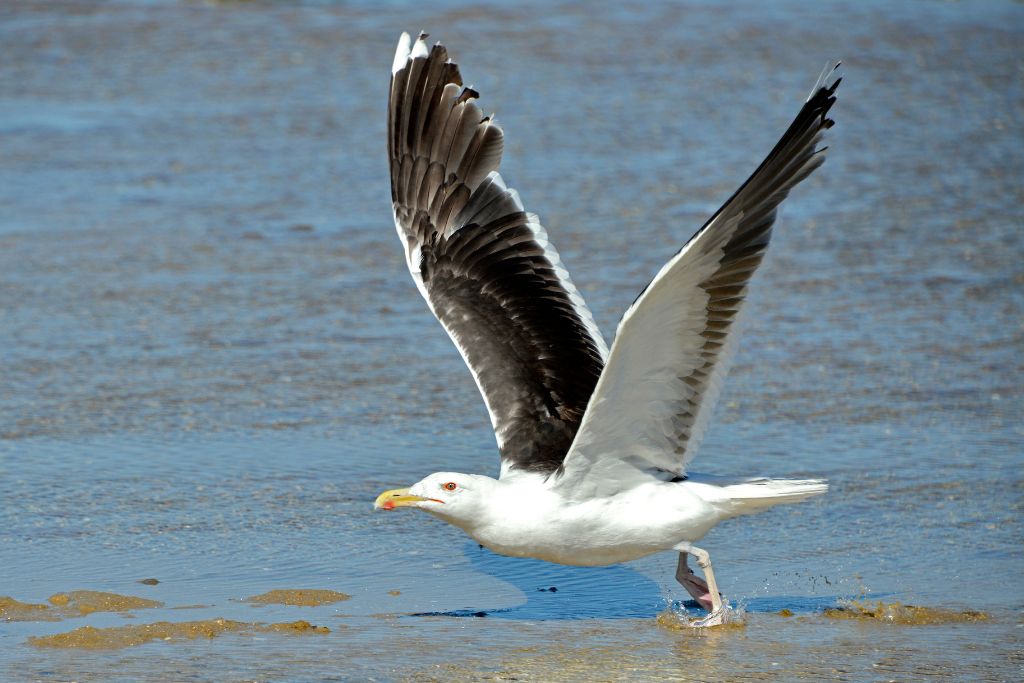
With a length and wingspan of around 28 to 31 inches (71 to 79 cm) and 5.5 to 6.5 feet (167 to 200 cm), respectively, the great black-backed gull (Larus marinus) is the largest gull species in the world.
It has a robust build with a black back, dark wings, and a white head and underbody. This gull’s strong beak is yellow with a red spot, and its legs are pink. It is among the most common large birds in Michigan.
Coastal great black-backed gulls are well-adapted. Thanks to their powerful beaks and jaws, they eat fish, small mammals, birds, and carrion.
Their dark feathers help them hide when they are hunting or looking for food. Most of the time, these gulls live near shorelines, estuaries, ports, and cliffs along the coast, where they can easily get to places where they can find food.
Great black-backed gulls breed in colonies on islands or remote coastal locations. They make ground nests from grass, seaweed, and other materials. Monogamous pairs vigorously defend their nests.
The lifespan of the great black-backed gull is about 15 to 25 years. It hunts and searches for food. These gulls are flexible and have spread out to big lakes and reservoirs.
Great black-backed gulls are often seen along the Great Lakes and other large bodies of water in Michigan. They can be seen looking for food and making nests on beaches, docks, harbors, and other places along the coast.
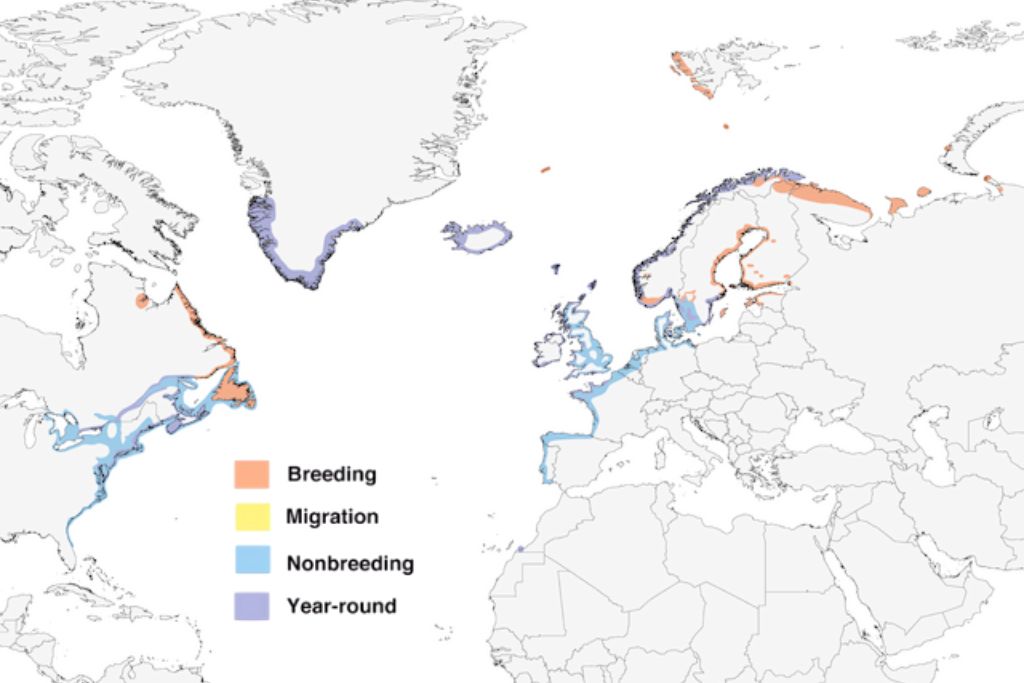
Some notable locations for spotting these gulls in Michigan include Sleeping Bear Dunes National Lakeshore, Pictured Rocks National Lakeshore, and Tawas Point State Park.
Turkey Vulture
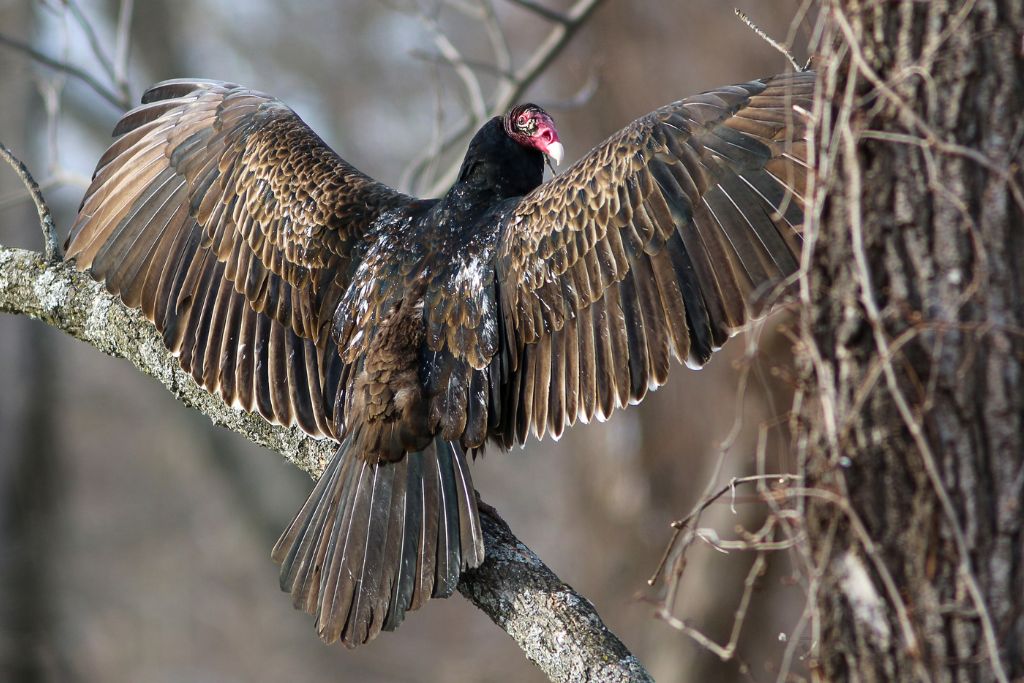
- Kingdom: Animalia
- Phylum: Chordata
- Class: Aves
- Order: Cathartiformes
- Genus: Cathartes
- Species: C. aura
Turkey vultures (Cathartes aura) can grow to 2.5 feet long and have a six-foot wingspan. They have red heads and dark brown to black feathers. Their hooked beaks rip flesh, and their excellent eyesight helps them find carrion from great elevations.
They have a highly developed sense of smell, allowing them to detect decaying flesh odor from great distances. These large birds can be spotted in various habitats, including forests, grasslands, and wetlands. They are often seen perched on treetops, fence posts, or soaring high in the sky while searching for food.
Turkey vultures don’t nest like other birds. They lay their eggs in hidden places, like caverns, hollow trees, or abandoned structures. Both parents incubate two eggs for 30 to 40 days.
Large birds in Michigan’s sounds can be easily heard in woodlands and fields are common.

Great Egret
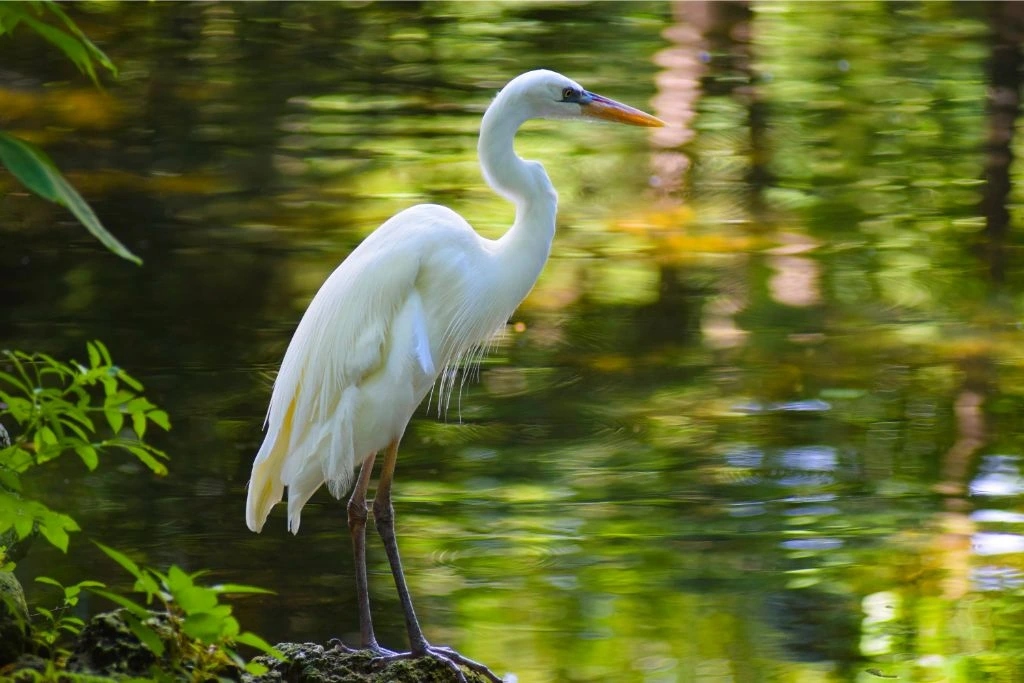
- Kingdom: Animalia
- Phylum: Chordata
- Class: Aves
- Order: Pelecaniformes
- Genus: Ardea
- Species: A. alba
They’re often found in Michigan’s marshes, estuaries, and Great Lakes coasts. Great Egrets (Ardea alba) visits Detroit River International Wildlife Refuge, Tawas Point State Park, and Shiawassee National Wildlife Refuge. They add diversity to Michigan’s enormous bird population and allow birdwatchers to see their beauty and grace in their native habitat.
Great Egrets are large birds, standing around 3 to 4 feet tall with a wingspan of about 5 to 6 feet. They have long, slender bodies with white plumage, long necks, and dagger-like bills.
During the time of year when they are breeding, they get beautiful plumes on their backs. These birds are known for moving slowly to stay still for long amounts of time while they wait for their prey.
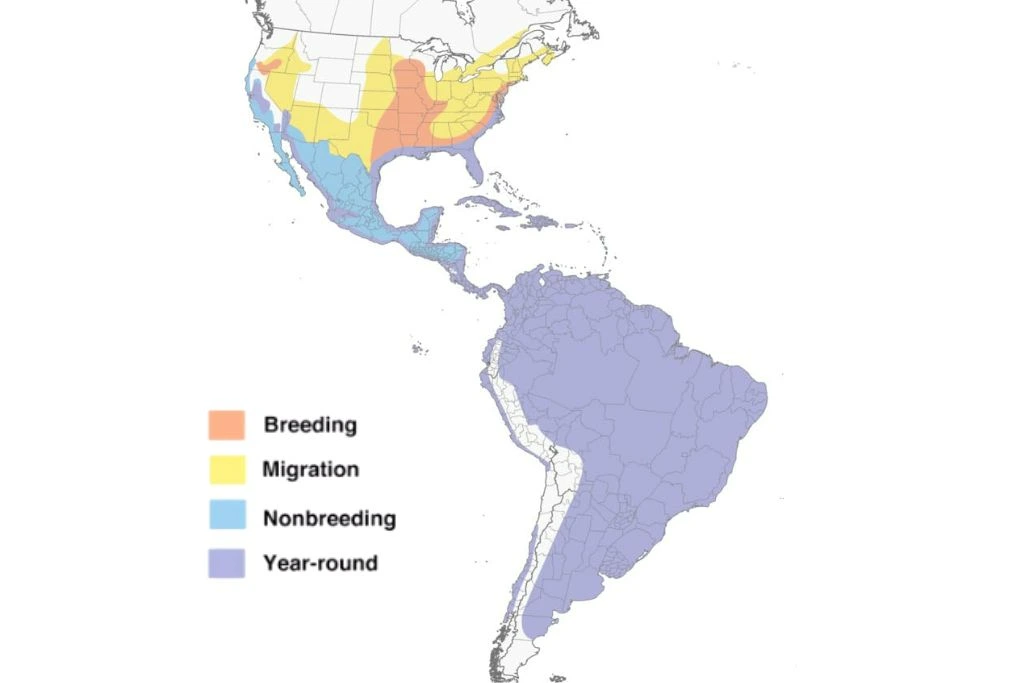
They build big nests out of sticks in the highest trees. During courtship, breeding pairs do things like point their bills, turn their heads, and give twigs. The female lays 3 to 4 eggs, and both parents take care of them for about 3 weeks.
Caspian Tern
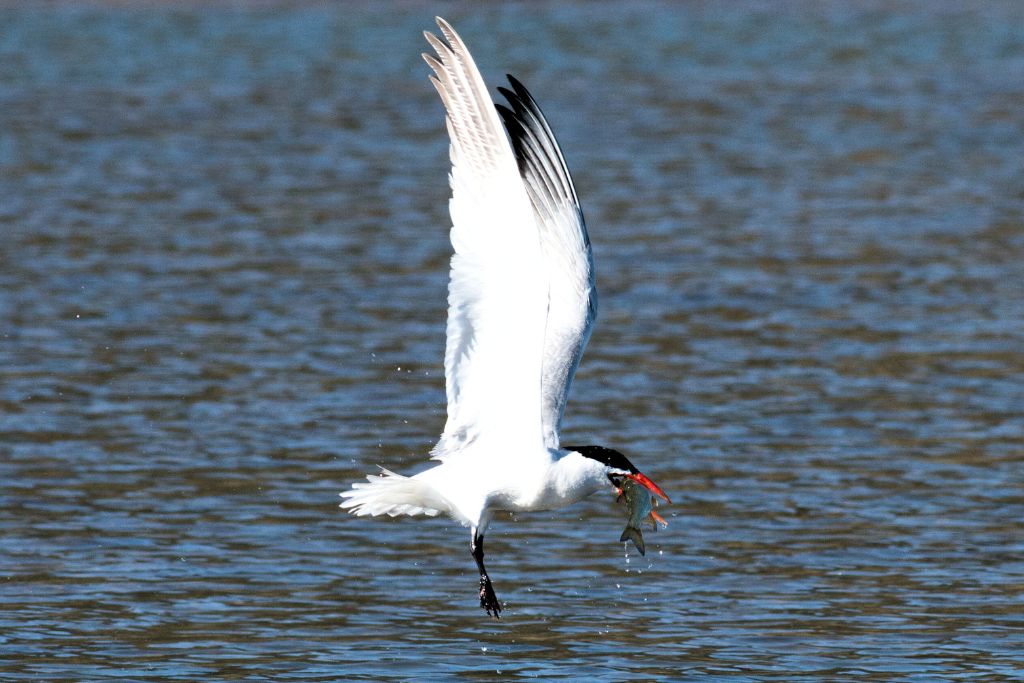
- Kingdom: Animalia
- Phylum: Chordata
- Class: Aves
- Order: Charadriiformes
- Genus: Hydroprogne
- Species: H. caspia
Caspian terns (Hydroprogne caspia) are large birds measuring about 20 to 23 inches in length with a wingspan of approximately 50 inches. They have a striking appearance with a black cap on their head, a red-orange bill, and a white body. Their long, pointed wings and forked tails make them agile flyers. They have a loud, harsh call that resembles a sharp “koww-koww-koww” sound.
Terns are great at catching fish from the air and can dive straight down into the water from a great height. They eat mostly fish but may also eat crustaceans and other small species living in water. An incredible sight for birdwatchers and people who like nature because they are big and look different.

They are commonly sighted along coastlines, estuaries, lakes, rivers, and even large reservoirs, showcasing their adaptability to various bodies of water. These birds thrive in diverse habitats, from freshwater to saltwater environments.
Pileated Woodpecker
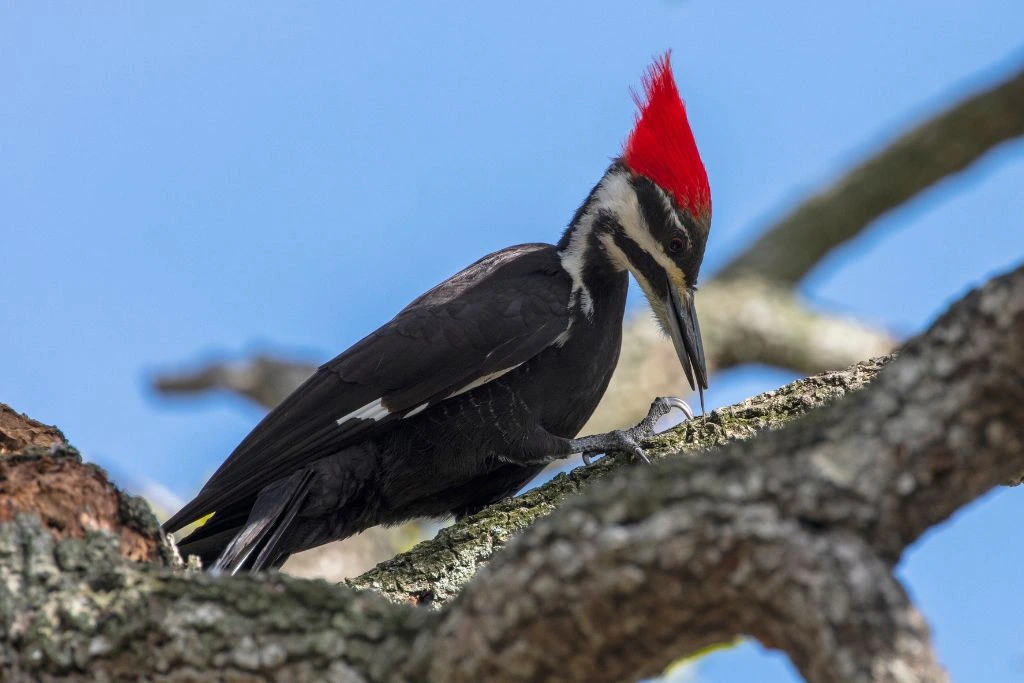
- Kingdom: Animalia
- Phylum: Chordata
- Class: Aves
- Order: Piciformes
- Genus: Dryocopus
- Species: D. pileatus
One of the largest woodpeckers in North America, the pileated woodpecker (Dryocopus pileatus) reaches 16 to 19 inches in length. Its remarkable look is the result of its black body, red crest, and white stripes on its face and neck.
This woodpecker has a powerful, chisel-like bill, which it uses to excavate large rectangular holes in trees in search of insects. Its long, barbed tongue helps it extract prey from crevices.
The Pileated woodpecker is known for its loud, resonant calls. It is often described as a series of “wuk-wuk-wuk” or “kuk-kuk-kuk” sounds, which can be heard over long distances.
Pileated woodpeckers are primarily found in mature forests with large trees, relying on them for nesting cavities and foraging. These woodpeckers have excellent excavation skills, allowing them to create nest cavities and search for food by pecking at trees.
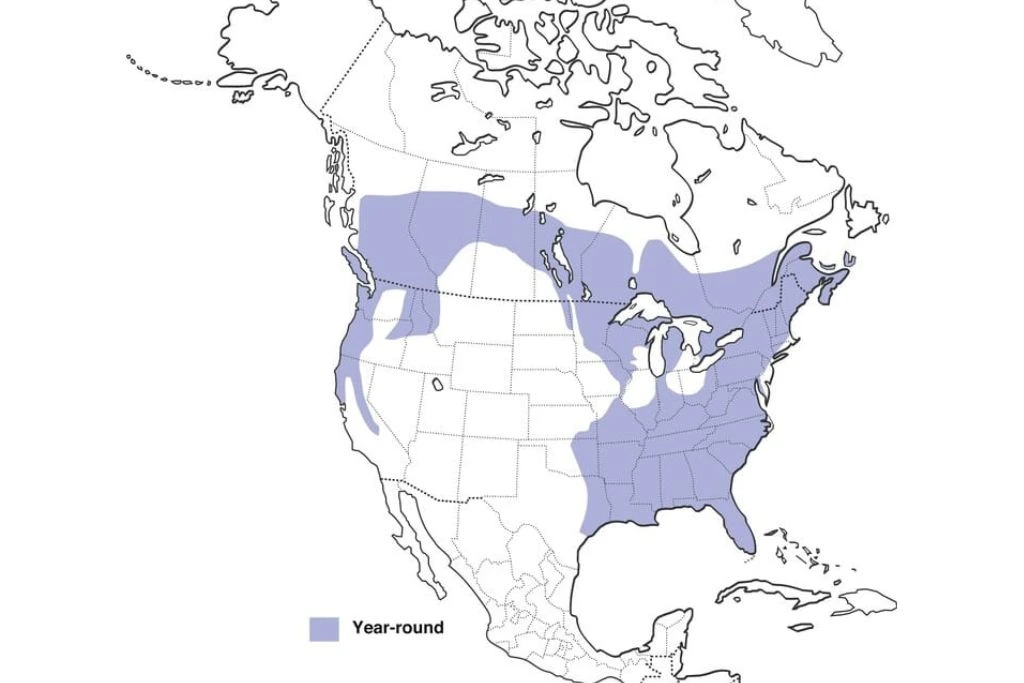
One of the most common large birds in Michigan is the pileated woodpecker. They can be observed in mature forests with a mix of deciduous and coniferous trees. They prefer areas with abundant large trees suitable for nesting and foraging.
The average life of pileated woodpeckers is around 5 to 10 years, but they can live up to 15 to 20 years.
Canada Goose
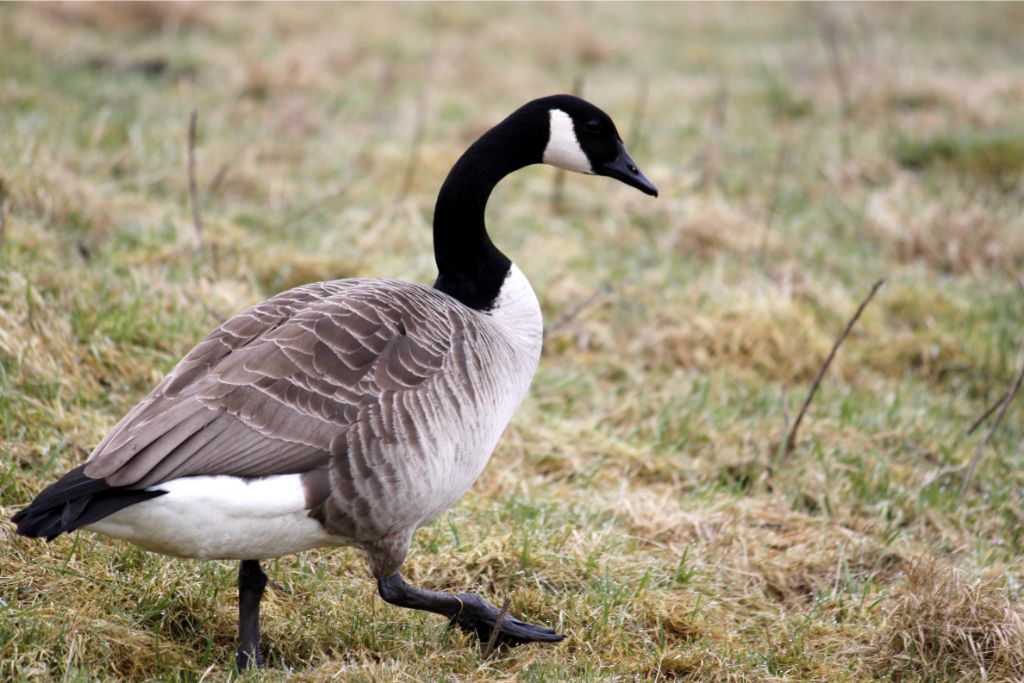
- Kingdom: Animalia
- Phylum: Chordata
- Class: Aves
- Order: Anseriformes
- Genus: Branta
- Species: B. canadensis
Canada geese (Branta canadensis) have strong, powerful wings that enable them to fly long distances. They can reach speeds of up to 40 miles per hour during migration.
The Canada goose is a large bird, measuring around 30 to 43 inches long, with a wingspan of 50 to 73 inches. It has a distinctive black head and neck, white chinstrap, brown body, and long black neck and legs.
When flying long distances, Canada geese often form a V-shaped or diagonal line formation, which helps reduce wind resistance and allows them to conserve energy. They are well adapted to both land and water. They inhabit various wetland habitats, including lakes, rivers, ponds, marshes, and coastal areas.
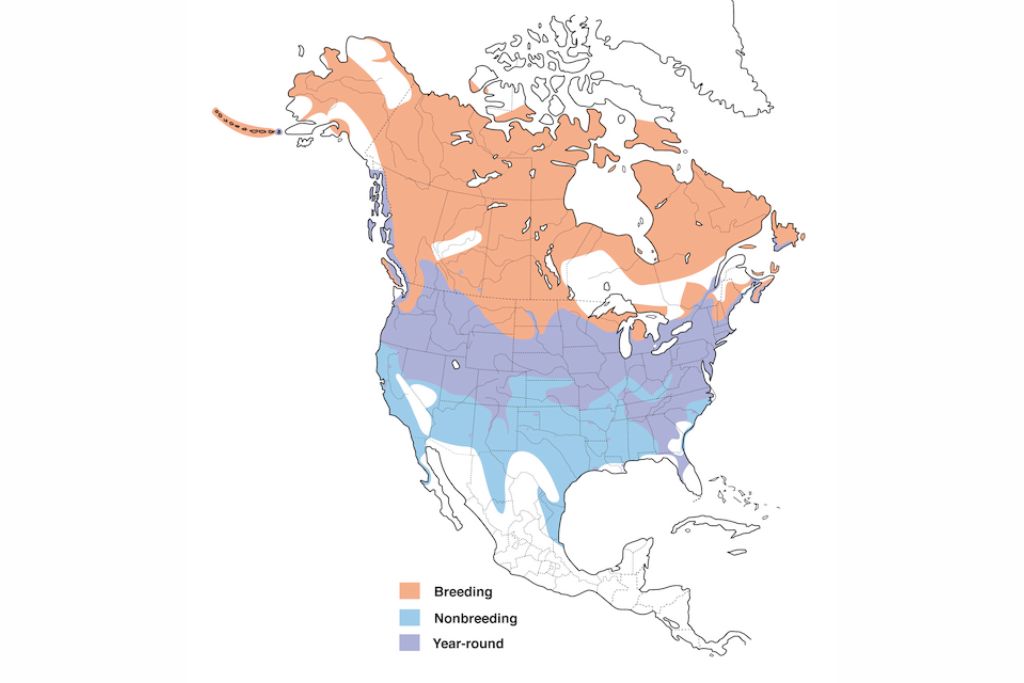
Did you know that Canada geese are a familiar sight in Michigan’s diverse landscapes? These adaptable birds can be spotted in various environments, from urban parks to serene lakes and wetland areas. They have successfully adapted to human-altered habitats and are often found in close proximity to human settlements.
Golden Eagle
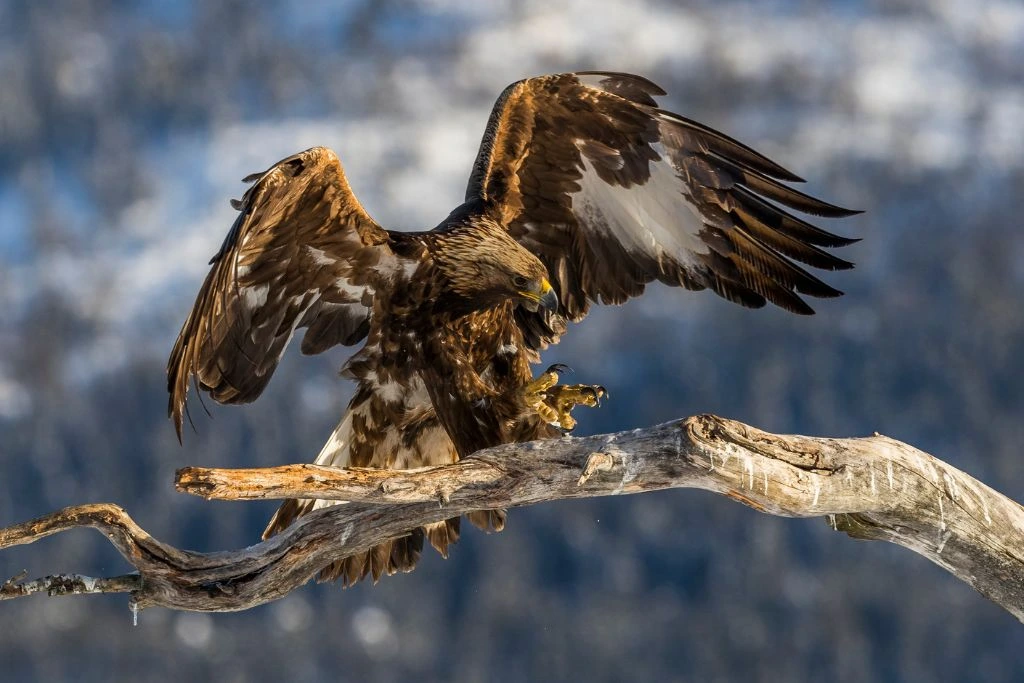
- Kingdom: Animalia
- Phylum: Chordata
- Class: Aves
- Order: Accipitriformes
- Genus: Aquila
- Species: A. chrysaetos
The wingspan of a golden eagle (Aquila chrysaetos) can exceed 7.5 feet, and its body weight can range from 8 to 14 pounds. They have dark brown feathers, a pale spot on the bottom of their beaks, and a golden brown nape.
These eagles have a keen sense of hearing, which helps them locate small mammals and birds.
One of their advantages to other birds is that they have excellent eyesight that helps them spot prey from great distances, and their strong wings allow them to soar effortlessly in search of food.
Golden eagles are good hunters. They eat small to medium-sized species, like rabbits, squirrels, and groundhogs. They have strong, crushing talons that let them catch animals that are bigger than themselves.
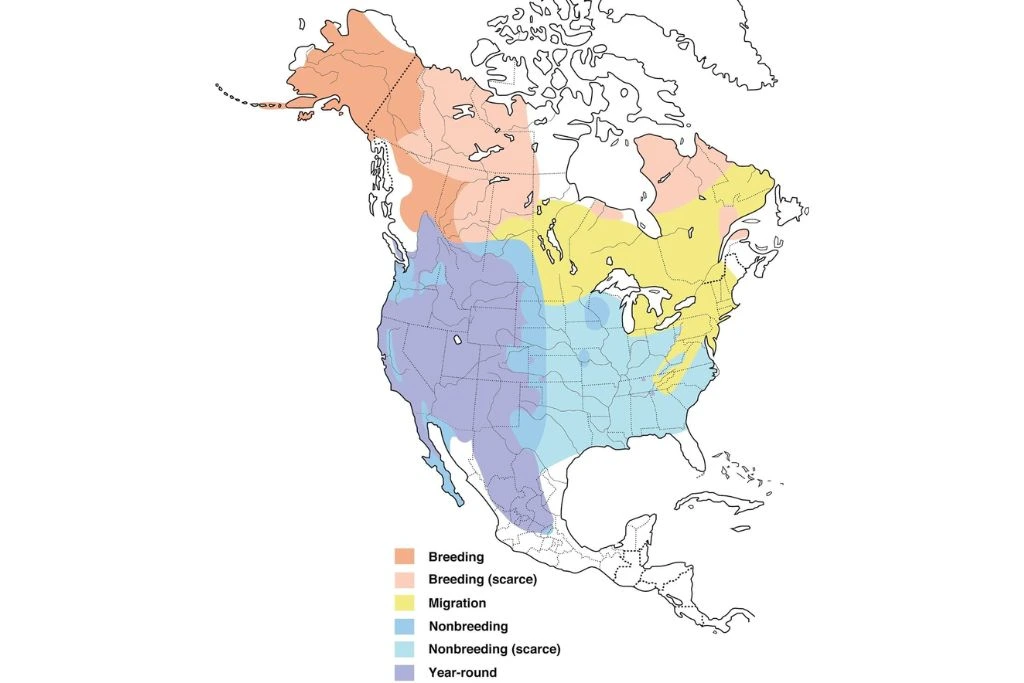
These eagles are known for their amazing flying skills. During courtship shows, they can fly up to 150 miles per hour. The average lifespan of a golden eagle in the wild is between 15 and 20 years.
Great Horned Owl
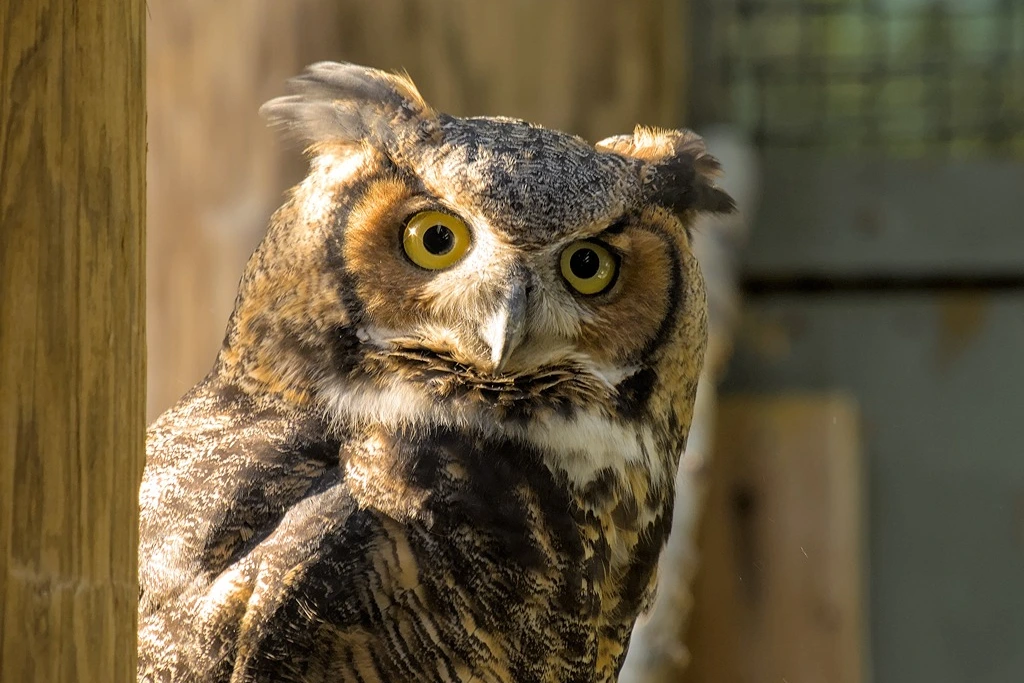
- Kingdom: Animalia
- Phylum: Chordata
- Class: Aves
- Order: Strigiformes
- Genus: Bubo
- Species: B. virginianus
Great horned owls (Bubo virginianus) are large birds, measuring around 18 to 25 inches (45 to 63 cm) in height. They have prominent feather tufts on their heads, often mistaken for horns, and striking yellow eyes. Their feathers can vary from gray-brown to reddish-brown, providing excellent camouflage in their natural habitats.
Their asymmetrical ear placements provide them acute hearing, which they use to pinpoint the exact location of their prey. You can spot one of these owls everywhere from a forest or woodland to a desert or even a city.
Great horned owls nest in tree cavities. For a month, both parents incubate 1 to 4 eggs laid by the female owl for a month. The young owlets stay in the nest for weeks until they can fly independently on their own.
They’ll consume whatever is available, which may be anything from rabbits and mice to snakes and frogs. These owls are equipped with keen claws and a powerful beak, allowing them to kill and eat a wide variety of prey.

Great horned owls can be seen throughout Michigan in various settings, including metropolitan areas with adequate tree cover. These birds have adapted well to their environment and can be found all around the state.
Rough-Legged Hawk
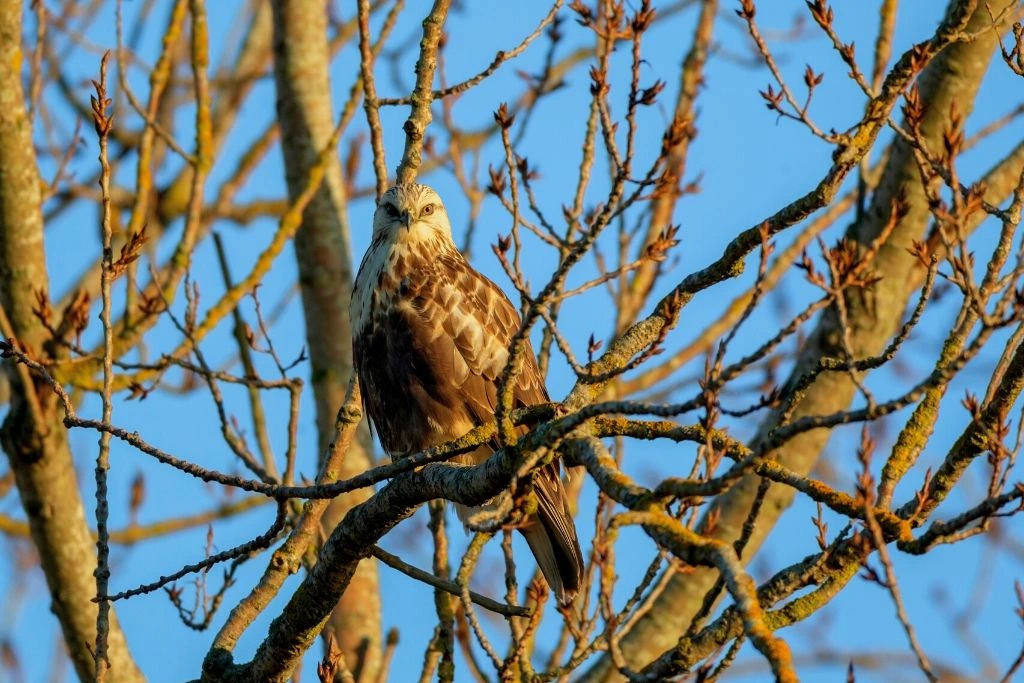
- Kingdom: Animalia
- Phylum: Chordata
- Class: Aves
- Order: Accipitriformes
- Genus: Buteo
- Species: B. lagopus
One of the defining features of the rough-legged hawk (Buteo lagopus) is its size. It commands attention in the sky with a wingspan of approximately 4.5 to 5.5 feet.
Its appearance is equally captivating, with long wings and a feathered face that gives it a majestic aura. Interestingly, the hawk’s legs are covered in feathers down to its feet, providing insulation against the harsh cold of its Arctic breeding grounds.
Speaking of adaptations, the rough-legged hawk boasts exceptional vision and hearing, allowing it to spot and locate prey from great distances. This ability comes in handy during its hunting expeditions, as it primarily preys on small mammals, like voles, mice, and lemmings.
The rough-legged hawk lives and breeds in the Arctic tundra, but it moves to warmer places like Michigan in the winter. It lives here in grasslands, fields, and marshes, all open places. You can find this beautiful bird sitting on trees, poles, or even floating in the air while it looks for food on the ground.
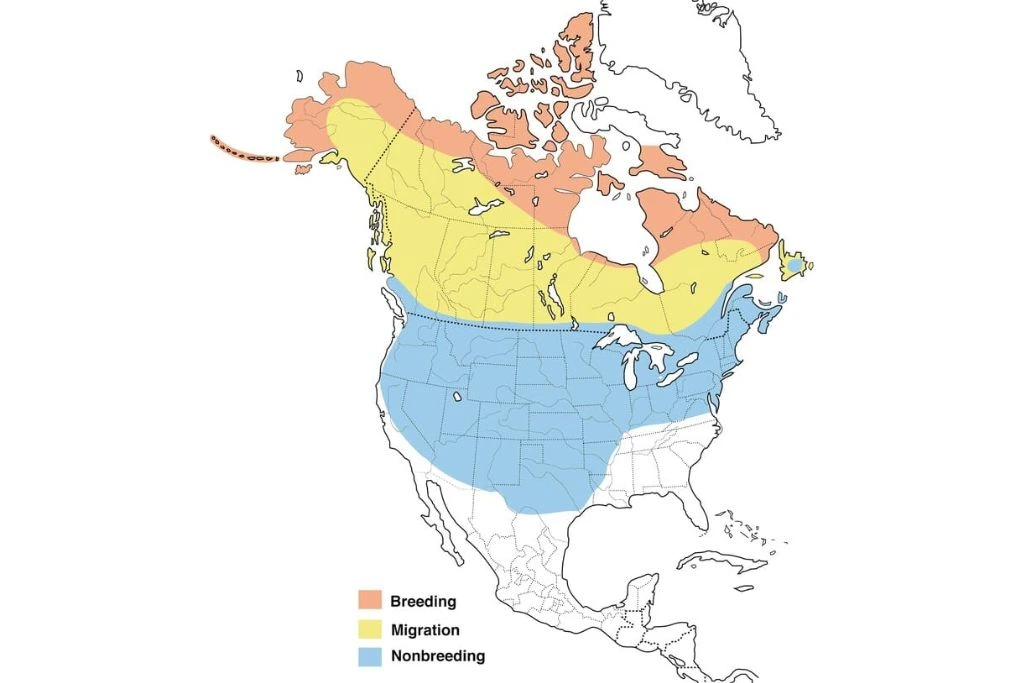
An intriguing fact about rough-legged hawks is their long-distance migration. These birds travel impressive distances from their Arctic breeding grounds to their wintering areas. With their endurance and adaptability, they have become a symbol of resilience in the avian world.
Sandhill Crane
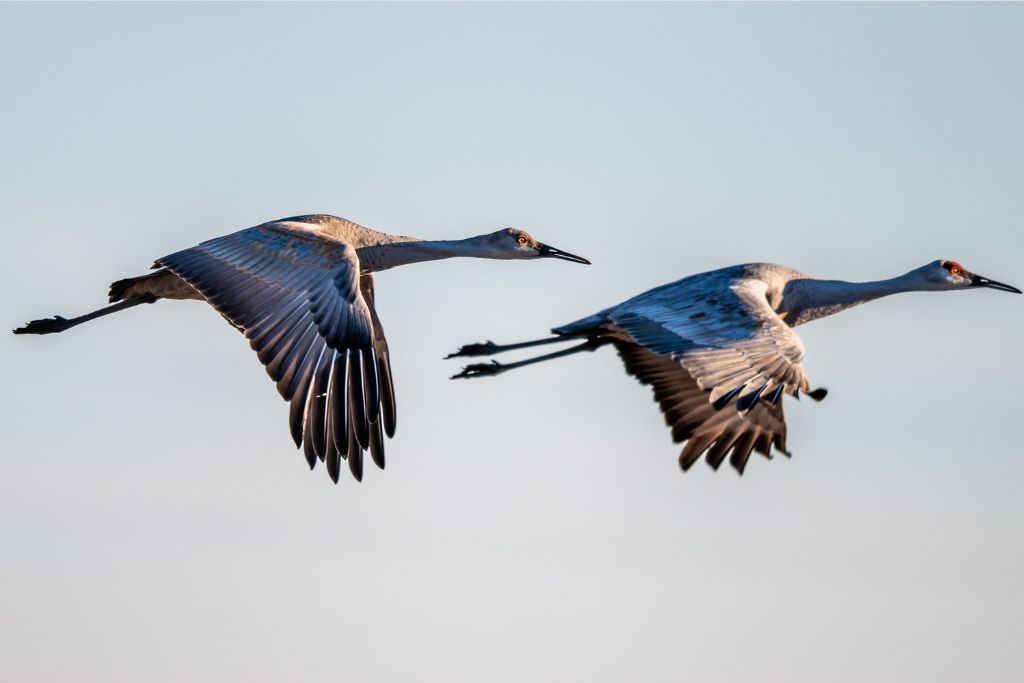
- Kingdom: Animalia
- Phylum: Chordata
- Class: Aves
- Order: Gruiformes
- Genus: Antigone
- Species: A. canadensis
The Sandhill crane (Antigone canadensis) is a beautiful and unique bird living in Michigan’s wetlands. These beautiful birds catch our attention with a height of 3 to 4 feet and a wingspan of 5 to 7 feet. Their grayish-brown feathers and a bit of red on their foreheads make for an eye-catching sight.
Adapted to their watery habitats, sandhill cranes have long legs and necks, allowing them to navigate marshes, bogs, and prairie wetlands easily.
With their powerful wings, they take to the skies, soaring gracefully, befitting their stature, through the air. But their resonant trumpeting calls truly leave an impression, their reverberations echoing across the wetlands.
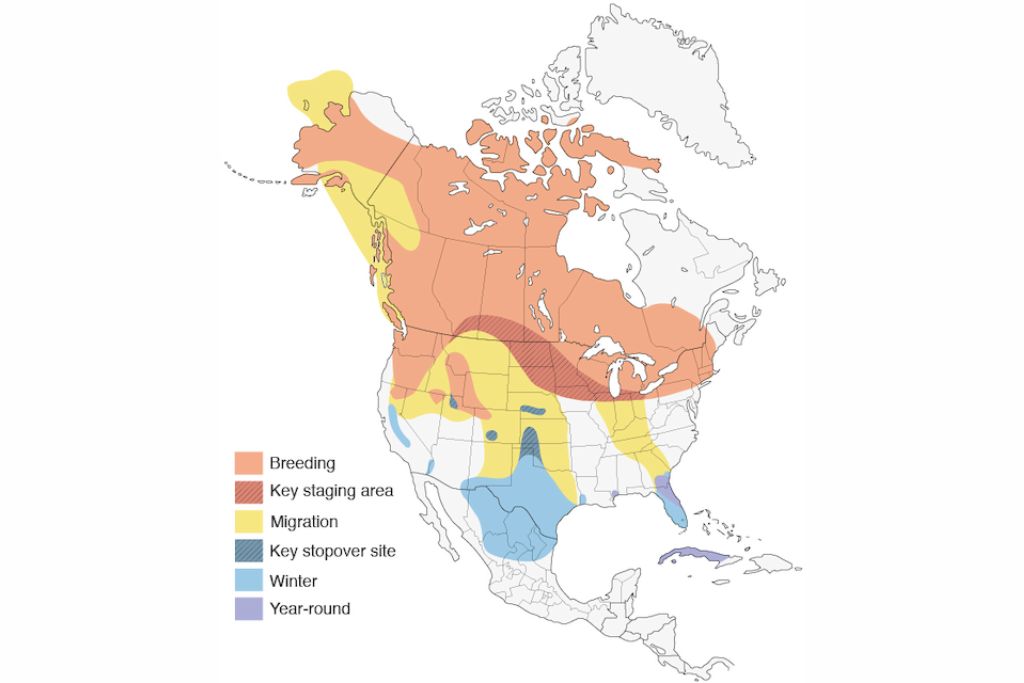
Did you know that sandhill cranes are long-lived birds? With a life expectancy of up to 20 years or more, they navigate the wetlands and skies with resilience.
Michigan is a vital stopover during their migratory journeys as they travel to and from their breeding grounds in the Northern United States and Canada. Their populations have rebounded thanks to conservation efforts, allowing us to witness their beauty and observe their captivating behaviors in various parts of Michigan.
Snowy Owl

- Kingdom: Animalia
- Phylum: Chordata
- Class: Aves
- Order: Strigiformes
- Genus: Bubo
- Species: B. scandiacus
In the vast snowy landscapes of Michigan, a majestic creature known as the Snowy Owl (Bubo scandiacus) graces our presence. These magnificent birds exhibit unique characteristics that set them apart.
Snowy Owls captivate our imagination with their striking white plumage, glowing yellow eyes, and an impressive wingspan of up to 5 feet. Their round heads, adorned with dark markings, give them a wise and enigmatic appearance.
Their thick feathers provide insulation and camouflage against the snowy backdrop, allowing them to blend seamlessly into their surroundings. These owls have keen eyesight and acute hearing, enabling them to spot prey from great distances.
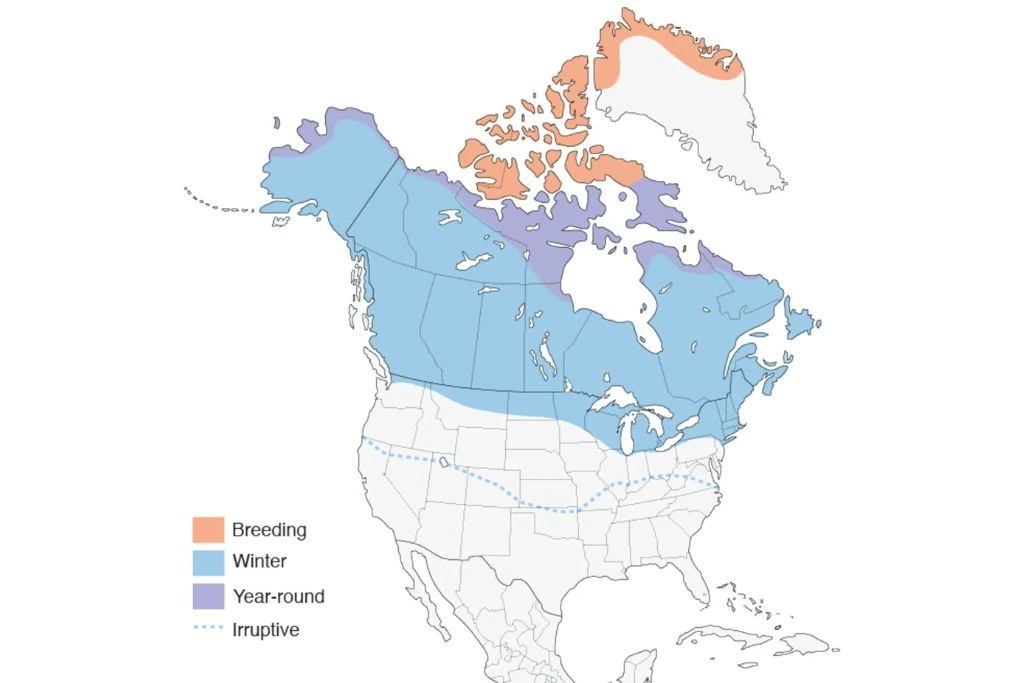
In Michigan, snowy owls are occasional visitors during the colder seasons, particularly along the coastlines and open fields. These sightings are highly anticipated by birdwatchers and nature enthusiasts, who eagerly seek out these magnificent birds in their temporary habitats.
Mute Swan
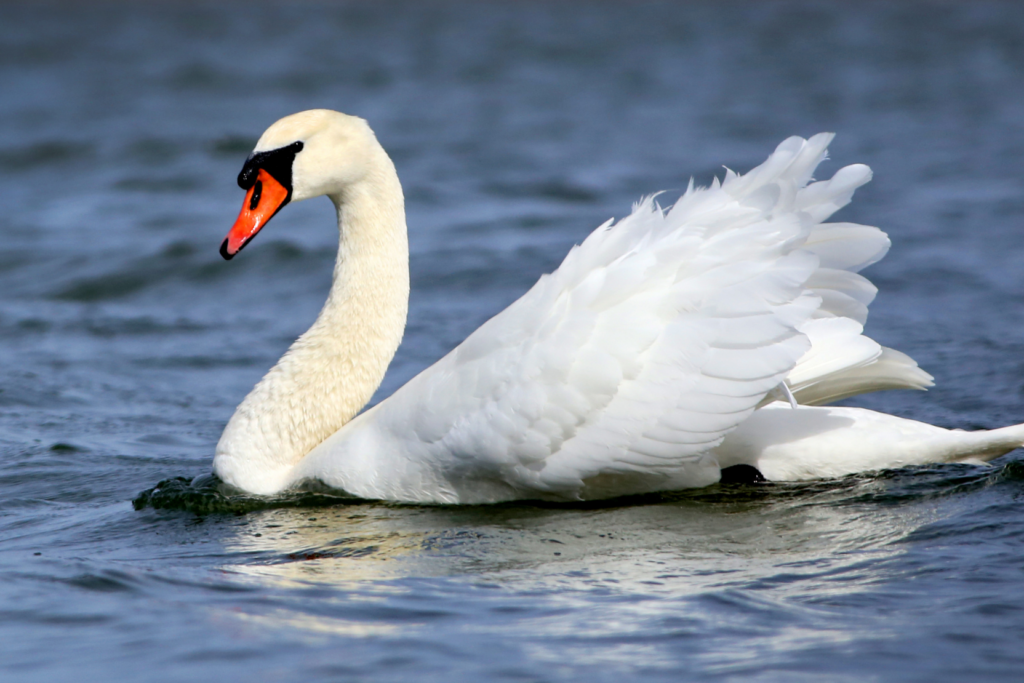
- Kingdom: Animalia
- Phylum: Chordata
- Class: Aves
- Order: Anseriformes
- Genus: Cygnus
- Species: C. olor
With their large size and striking white feathers, Mute Swans (Cygnus olor) are easy to spot and distinguish. They can reach a length of about 5 feet and have a wingspan of around 7 to 8 feet. What sets them apart is their distinctive orange bill, which contrasts beautifully with their white plumage.
Their long necks allow them to reach underwater to feed on aquatic plants gracefully. At the same time, their webbed feet help them navigate the water. They are strong swimmers and can gracefully glide across lakes, ponds, and slow-moving rivers.
Despite their name, Mute swans are not completely silent. They produce a variety of vocalizations, including soft hisses, honks, and whistles.
When it comes to nesting and breeding, mute swans are highly territorial. They build their nests on the water’s edge, often using vegetation and other materials to create a mound-like structure. They are protective parents and fiercely defend their young against perceived threats.
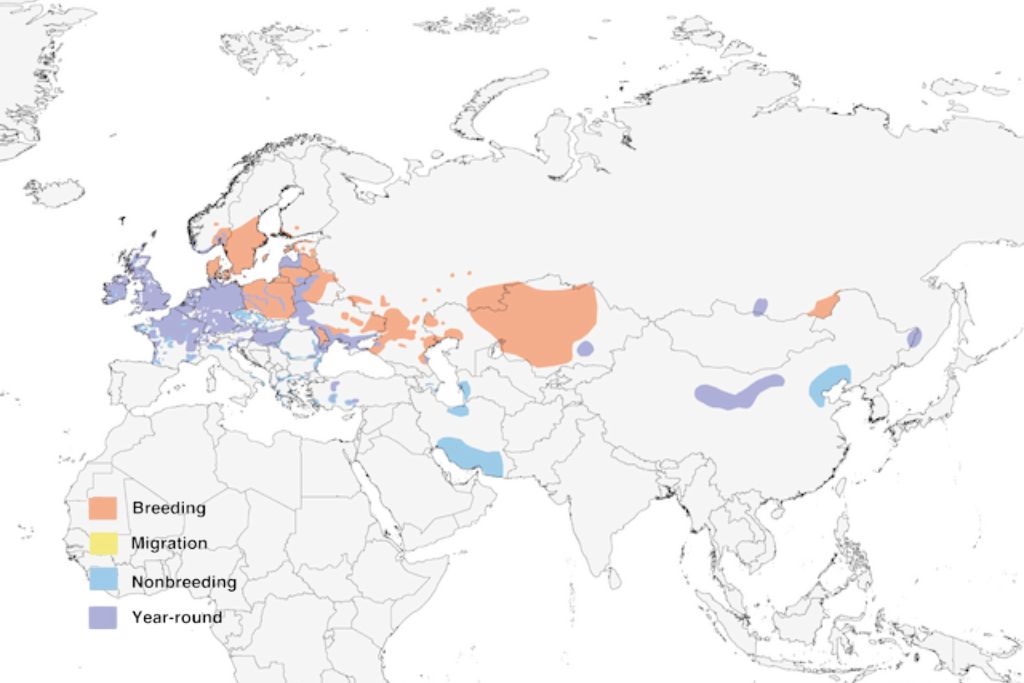
Mute Swans are commonly found in lakes, ponds, and slow-flowing rivers in Michigan. They are often seen gracefully gliding across the water or nesting near the shoreline. Their presence adds beauty to the natural landscapes of Michigan and captivates the hearts of those who observe them.
The average longevity of a Mute Swan is around 20 years, making it one of the longest-lived bird species. Some of them have lived for 30 years or more!
FAQs
Does Michigan Have Large Birds?
Yes, Michigan is home to a variety of large birds. The state’s diverse habitats provide suitable conditions for several species of large birds to thrive.
What Are the Most Common Large Birds in Michigan?
Some of the most common large bird species found in Michigan are Bald Eagles, Sandhill Crane, and Great Blue Heron.
Are There Any Endangered Bird Species in Michigan?
Yes. Kirtland’s warbler, Great Lakes piping plover, and others. Conservation organizations, government agencies, and individuals are protecting and restoring these endangered bird species’ habitats to ensure their long-term existence.
How Do I Attract Large Birds to My Backyard in Michigan?
To attract large birds to your backyard in Michigan, you can make it a welcome place by giving them food, water, and a place to stay. Put out bird feeders with various seeds, nuts, and fruits that larger birds like. Consider putting in a birdbath or a small water feature to give birds a place to drink and bathe.

